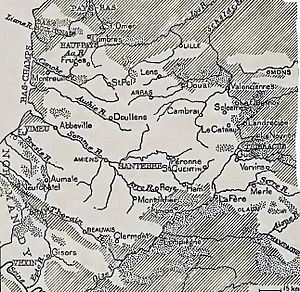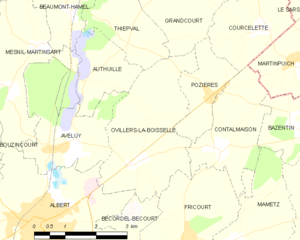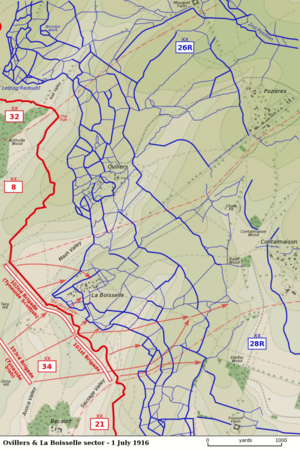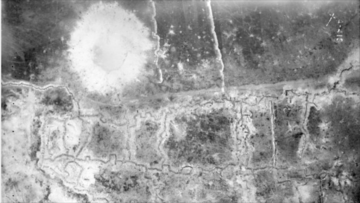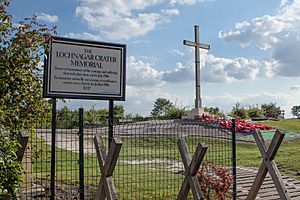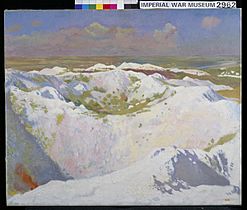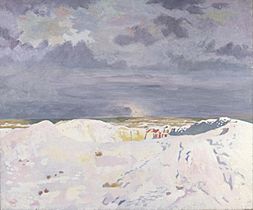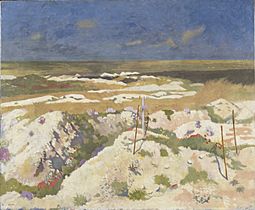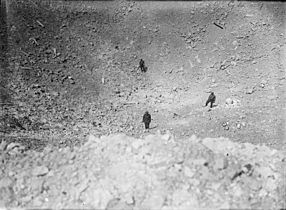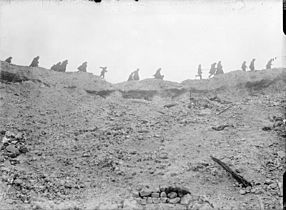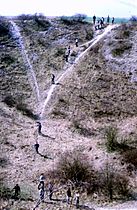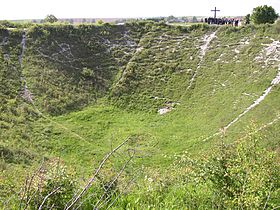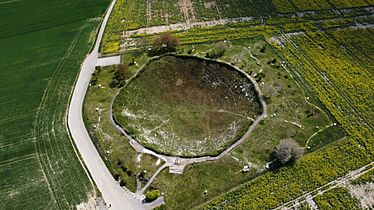Lochnagar mine facts for kids
Quick facts for kids Lochnagar mine |
|||||||
|---|---|---|---|---|---|---|---|
| Part of the Battle of the Somme, First World War | |||||||
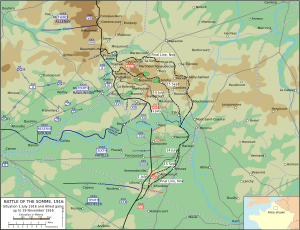 Battle of the Somme 1 July – 18 November 1916 |
|||||||
|
|||||||
| Belligerents | |||||||
| Commanders and leaders | |||||||
| Douglas Haig | Erich von Falkenhayn | ||||||
The Lochnagar mine was a huge underground bomb. British soldiers secretly placed it during the First World War. It was located near the village of La Boisselle in France. The mine was set to explode on 1 July 1916, the first day of the Battle of the Somme.
Specialist soldiers called Tunnelling Companies of the Royal Engineers dug the mine. They dug it under a German army position known as Schwabenhöhe (Swabian Height). A very large hole, called the Lochnagar crater, still exists today. It is also known as the Trou de mine de La Boisselle.
The British named the mine after Lochnagar Street. This was the trench where they started digging the tunnel. The Lochnagar mine was one of 19 mines dug under German lines. These mines helped the British soldiers advance at the start of the battle.
The mine exploded at 7:28 a.m. on 1 July 1916. It created a crater 21 m (69 ft) deep and 100 m (330 ft) wide. British troops quickly captured and held this crater. The crater is now a preserved memorial. A special service is held there every year on 1 July.
The Start of Underground Warfare
Fighting in 1914
Fighting began in the Somme region of France in September 1914. German forces tried to move west towards Albert. However, French soldiers stopped them at La Boisselle. Both sides then started to dig tunnels and fortify their positions.
On 18 December, French troops captured a cemetery in La Boisselle. This put them very close to the German front line. By Christmas Day 1914, French engineers began digging the first mine shaft at La Boisselle.
Underground Battles in 1915
Fighting continued fiercely in the area between the two armies, called no man's land. This area was very narrow near La Boisselle, sometimes only 50 yd (46 m) wide. It became full of craters from explosions.
British engineers took over the French mine workings. They formed new Tunnelling Companies. These companies worked to dig new tunnels and destroy enemy tunnels. They also set explosives.
Keeping the mining secret was very important. Soldiers worked quietly, using special tools and even working barefoot. They carefully removed rocks and stored the dirt. This dirt was later used to pack the explosives.
On 19 November, a British officer thought German miners were very close. He ordered a large amount of explosives to be placed quickly. The Germans then set off their own bomb, which accidentally set off the British one. From April 1915 to January 1916, many mines were exploded in this area. Some of these mines contained huge amounts of explosives.
Preparing for the Big Attack
Plans for 1916
The Battle of Albert began on 1 July 1916. La Boisselle was a key target for the British attack. Royal Engineer tunnelling companies had two main tasks. First, they had to place 19 mines under German positions. Second, they prepared shallow tunnels called "Russian saps." These saps would let soldiers attack from a shorter distance.
At La Boisselle, four mines were prepared. Two mines, named No 2 and No 5, were meant to destroy German tunnels. They would also create mounds of earth to block enemy fire.
The Germans had made the ruined houses and craters in La Boisselle very strong. This made a direct attack on the village very difficult. So, the British dug the Y Sap and Lochnagar mines. These mines were named after the trenches they started from. They were dug to help attacks on both sides of the German positions in the village.
The 185th Tunnelling Company started digging the Lochnagar mine on 11 November 1915. It was a dangerous job. On 4 February, a German explosion killed several British soldiers and officers. The digging was later taken over by the 179th Tunnelling Company.
Building the Lochnagar Mine
The Lochnagar mine had two explosive chambers. They shared one long access tunnel. The tunnel started from a trench called Lochnagar Street. Many British trenches in this area had Scottish names.
The tunnel sloped down to about 95 ft (29 m) deep. It began 300 ft (91 m) behind the British front line. It was also 900 ft (270 m) away from the German front line. To keep quiet, the miners used bayonets with long handles. They worked barefoot on sandbags. They carefully removed flints from the chalk.
When the tunnel was about 135 ft (41 m) from the German position, it split into two branches. Each branch ended in a chamber for the explosives. These chambers were about 60 ft (18 m) apart and 52 ft (16 m) deep. The access tunnel was 4.5 by 2.5 ft (1.37 by 0.76 m) wide. Miners dug about 18 in (460 mm) per day. The tunnel ended directly under the German Schwabenhöhe.
The mine was filled with 60,000 lb (27 long tons; 27 t) of ammonal explosive. This was split into two charges. The tunnels leading to the chambers were also filled with explosives. The tunnels did not quite reach the German front line. However, the explosion would create a 15 ft (4.6 m) high rim and bury nearby trenches. The Lochnagar and Y Sap mines were "overcharged." This meant they had extra explosives to make sure huge rims were formed.
British miners could hear German miners working below Lochnagar. They could also hear them above the Y Sap mine. One officer described the tension of listening for the enemy. He said they were only five feet apart from the Germans at one point.
The Day of the Explosion
1 July 1916
The four mines at La Boisselle exploded at 7:28 a.m. on 1 July 1916. This was the first day of the Battle of the Somme. Captain James Young of the 179th Tunnelling Company set off the Lochnagar mine. He confirmed that the explosion was successful.
The Lochnagar mine created a huge, smooth-sided crater. It was 220 ft (67 m) wide without the lip, and 450 ft (140 m) across including the lip. It destroyed hundreds of feet of German dugouts. These dugouts were full of German soldiers. The Lochnagar mine, along with the Y Sap mine, was one of the largest mines ever exploded.
The sound of the Lochnagar blast was incredibly loud. It was considered the loudest man-made noise in history at that time. People reported hearing it all the way in London. Even louder mines would be exploded a year later in the Battle of Messines.
British soldiers from the Grimsby Chums, a special volunteer battalion, attacked this area. They quickly occupied the crater. They began to fortify its eastern edge, which gave them a good view. However, German counter-attacks forced them back to the crater. German artillery then heavily shelled the crater.
Witnessing the Blast from the Air
Pilots flying over the battlefield saw the Y Sap and Lochnagar mines explode. They were there to report on British troop movements. 2nd Lieutenant Cecil Arthur Lewis was one of these pilots. He was warned not to fly too close. He watched from almost two miles away.
Lewis later described the amazing sight in his book Sagittarius Rising:
We were over Thiepval and turned south to watch the mines. As we sailed down above all, came the final moment. Zero! At Boisselle the earth heaved and flashed, a tremendous and magnificent column rose up into the sky. There was an ear-splitting roar, drowning all the guns, flinging the machine sideways in the repercussing air. The earthly column rose, higher and higher to almost four thousand feet. There it hung, or seemed to hang, for a moment in the air, like a silhouette of some great cypress tree, then fell away in a widening cone of dust and debris. A moment later came the second mine. Again the roar, the upflung machine, the strange gaunt silhouette invading the sky. Then the dust cleared and we saw the two white eyes of the craters. The barrage had lifted to the second-line trenches, the infantry were over the top, the attack had begun.
—Cecil Lewis, whose aircraft was hit by lumps of mud thrown up by the explosion.
Air observers reported that British troops had advanced in some areas. However, the villages of La Boisselle and Ovillers had not yet been captured. On 3 July, flares were seen in the village. These helped British forces understand where their troops were.
A communication tunnel was used to reach soldiers near the new crater. Troops from the 9th Cheshires moved forward into the crater. They fought off several German counter-attacks. On 2 July, wounded soldiers began to be evacuated. On 3 July, troops pushed forward from the crater, gaining a small area.
Remembering the Lochnagar Mine
William Orpen, an official war artist, visited the Somme battlefield in 1916. He described the crater area as a wilderness of white chalk. John Masefield also visited and described the area as dazzlingly white.
After the war, many smaller craters were filled in. However, the Lochnagar mine crater remained. People tried to fill it, but these efforts were stopped. An Englishman named Richard Dunning bought the land to protect it. He was inspired after reading The Old Front Line.
Dunning bought the crater in the 1970s. He put up a memorial cross on the crater's rim in 1986. The cross was made from old church timber. It was struck by lightning but was repaired.
Today, the site attracts about 200,000 visitors each year. An annual memorial service is held on 1 July. This service remembers the mine's explosion and all the soldiers who died. Poppy petals are scattered into the crater. Richard Dunning was honored with an MBE in 2017 for his work in preserving the site.
Gallery
-
William Orpen: Mines and the Bapaume Road, La Boisselle (Art.IWMART2962)
See also
- List of the largest artificial non-nuclear explosions
- The Battle of the Crater from the American Civil War


